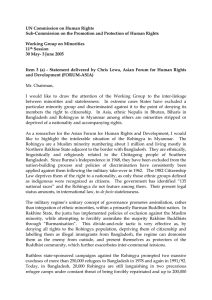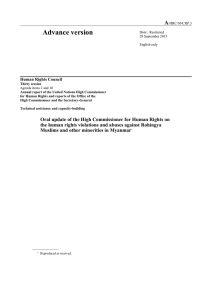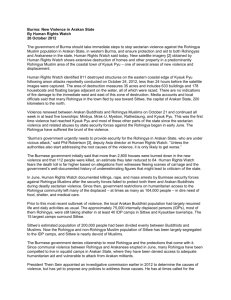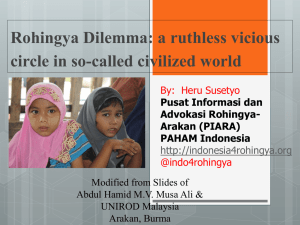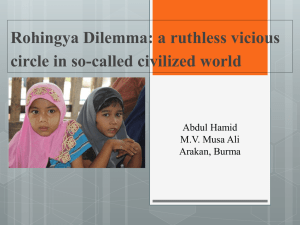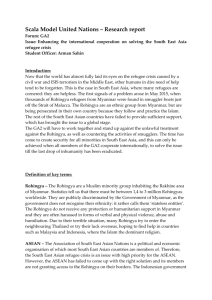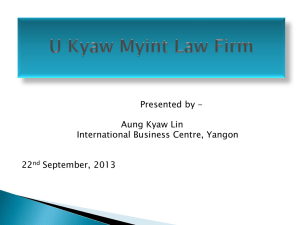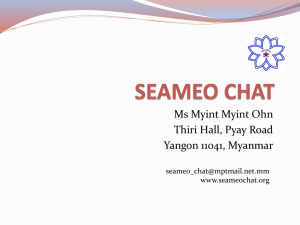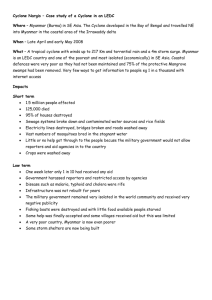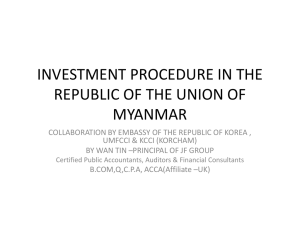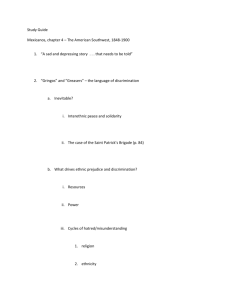Yale Report on Genocide of Rohingya Muslims
advertisement
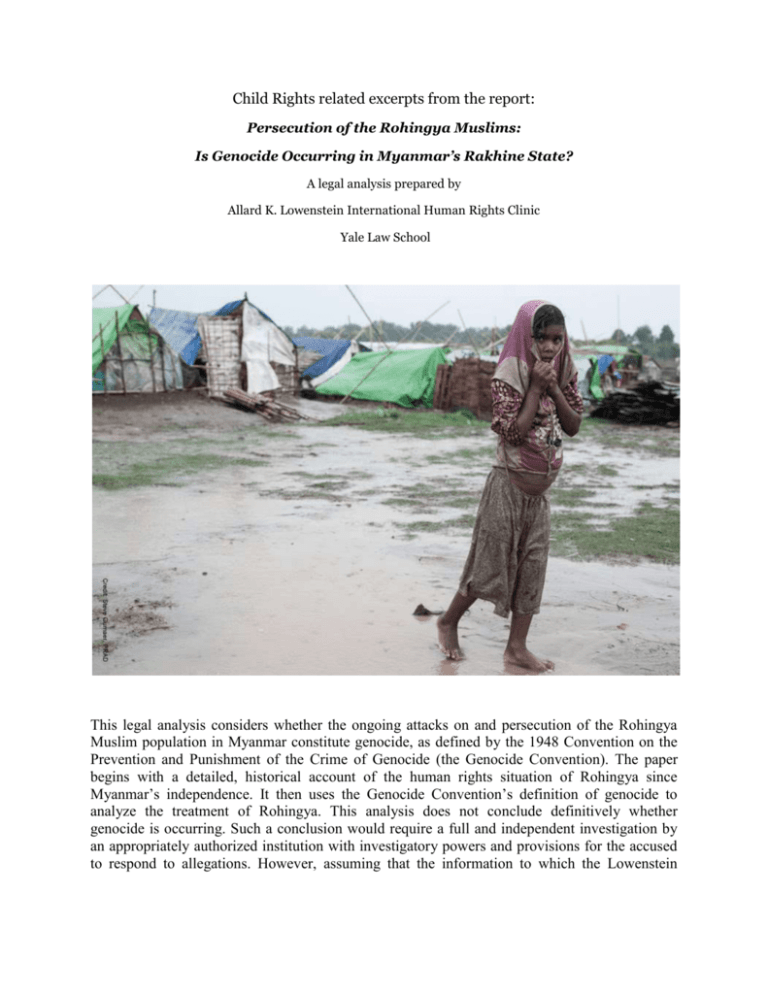
Child Rights related excerpts from the report: Persecution of the Rohingya Muslims: Is Genocide Occurring in Myanmar’s Rakhine State? A legal analysis prepared by Allard K. Lowenstein International Human Rights Clinic Yale Law School This legal analysis considers whether the ongoing attacks on and persecution of the Rohingya Muslim population in Myanmar constitute genocide, as defined by the 1948 Convention on the Prevention and Punishment of the Crime of Genocide (the Genocide Convention). The paper begins with a detailed, historical account of the human rights situation of Rohingya since Myanmar’s independence. It then uses the Genocide Convention’s definition of genocide to analyze the treatment of Rohingya. This analysis does not conclude definitively whether genocide is occurring. Such a conclusion would require a full and independent investigation by an appropriately authorized institution with investigatory powers and provisions for the accused to respond to allegations. However, assuming that the information to which the Lowenstein Clinic has had access is credible and comprehensive and accurately reflects the Rohingyas’ situation, the paper finds strong evidence that genocide is being committed against Rohingya. Article II of the Genocide Convention defines genocide as: [A]ny of the following acts committed with intent to destroy, in whole or in part, a national, ethnical, racial or religious group, as such: a) Killing members of the group; b) Causing serious bodily or mental harm to members of the group; c) Deliberately inflicting on the group conditions of life calculated to bring about its physical destruction in whole or in part; d) Imposing measures intended to prevent births within the group; e) Forcibly transferring children of the group to another group Denial of Citizenship After the military coup in 1962, the government began giving documentation to fewer and fewer Rohingya children, refusing to recognize fully new generations of the Rohingya population. Forced Labor Forced labor has continued to be practiced widely and systematically in Rakhine State. State security forces have conscripted Rohingya for forced labor, including sentry duty, road maintenance, and “camp related tasks.” From January to June 2014, more than 6,000 Rohingya adults and more than 2,000 Rohingya children were forced to work for the Myanmar authorities in northern Rakhine State. A Rohingya now living in Malaysia reported, “Since I was very young and attending school the police [and soldiers] would take me for forced labor. This is still happening in Myanmar.” Ninety-eight percent of these incidents of forced labor were perpetrated by the Myanmar Army. In its 2015 report to the U.N. Human Rights Council for Myanmar’s Universal Periodic Review, Fortify Rights alleged that since 2012, the Myanmar Army and other security forces have used forced labor from several thousand Rohingya in Northern Rakhine State, including children. Marriage Restrictions and Population Control The Myanmar government has imposed two types of measures designed to prevent Rohingya births: restrictions on Rohingya marriages and restrictions, applied only to Rohingya, on the number of children a family may have. Since 2005, to be allowed to marry, Rohingya must agree to have no more than two children. Violations of the two-child policy can also result in ten-year prison sentences. The Thein Sein government has continued to enforce policies to control the Rohingya population, including restrictions on the freedom of movement, marriage, childbirth, and other aspects of daily life in Rakhine. The two-child policy has led women to abort fetuses if they already have two children or if they are not legally married. Because abortion is illegal in Myanmar, women engage in unsafe abortions. Women who have had such abortions have fallen seriously ill. Some women who chose not to abort have gone to Bangladesh to give birth and then have left the children there to avoid repercussions from the NaSaKa authorities when they return to Myanmar. These instances reflect the realization of the government’s goals to deter Rohingya births and reduce the Rohingya population. Rohingya have reported that the Lon Htin, NaSaKa, Myanmar Army, and Myanmar Police Force were directly involved in violent attacks against them. Rohingya reported that they were powerless to stop attacks from Rakhine citizens; when they tried to defend themselves against Rakhine, Lon Htin police and the military opened fire with live ammunition, killing men, women, and children. Plight of Children and Conditions in Internally Displaced Person (IDP) Camps Rohingya living in IDP camps face chronic food shortages. The state government has routinely rejected requests of displaced Rohingya for food rations. Save the Children’s IDP Daily Status Updates from the same period documented lack of food, water, and medical care. Save the Children has documented the government’s failure to provide rations; on one day, it delivered 900 bags of rice instead of the 3,900 bags needed, with 12 bags half empty on arrival.225 The organization reported that some Rohingya resorted to eating glue On January 14, local officials ordered Lon Htin to arrest all male Rohingya, including children over the age of ten, in surrounding areas. According to Fortify Rights, riot police started rounding up all male Rohingya, including children, in the surrounding areas after the killings. Journalists and human rights organizations have described the IDP camps where at least 140,000 Rohingya reside as unlivable ghettos. Government forces highly regulate access to IDP camps around Sittwe. Daily IDP camp reports from the Danish Refugee Council and Save the Children have recorded regular government failure to deliver adequate food rations to the camps, lack of water, and lack of sanitation and medical care. According to UN and Amnestry International Data During the 2012 violence, the Myanmar Army, Myanmar Police Force, NaSaKa, and Rakhine citizens killed several hundred Rohingya men, women, and children in targeted attacks, according to U.N. data and information provided by human rights organizations, none of which are complete. In some villages, assailants hacked dozens of children to death and threw their bodies into fires. Further, uncounted deaths have resulted from avoidable deprivation of health care and humanitarian aid in IDP camps and in communities of non-displaced Rohingya. Since the 2012 violence, more than 160,000 Rohingya men, women, and children are estimated to have fled Myanmar. An unknown number of these asylum seekers have died on the journey, both at sea and at the hands of transnational criminal syndicates engaged in human trafficking. Amnesty International estimates that thousands of Rohingya may have died at sea in 2015 alone. Hundreds, if not more than one thousand, Rohingya may have been buried in mass graves in Thailand and Malaysia. In its Conclusion and Recommendation In light of this conclusion, the United Nations should adopt a resolution to establish a commission of inquiry on the human rights situation in Rakhine State, Myanmar. Previous commissions of inquiry have been established by various U.N. bodies and actors.391 However, in the current circumstances, the Human Rights Council would be an ideal body for establishing such a commission. The mandate of the Human Rights Council includes addressing “situations of violations of human rights, including gross and systematic violations” and “making recommendations thereon.” The Human Rights Council should adopt a resolution that mandates the commission of inquiry to conduct an urgent, comprehensive, and independent investigation of the widespread and systematic abuses committed against Rohingya. The commission should be tasked with establishing the facts and circumstances that, taken as a whole, may indicate that genocide has occurred or is occurring. The mandate should further task the commission, where possible, with identifying the perpetrators responsible for such crimes. Establishing the commission will allow for a thorough, independent investigation into the human rights situation in Rakhine State. The commission would have the institutional capacity and authority to gather the information needed to determine whether genocide has been committed against the Rohingya, particularly whether the element of intent has been satisfied. It would also have the authority to respond to and recommend institutional action to prevent further acts of genocide. The commission should endeavor to complete four main tasks: 1) investigate reports of violations, by all parties, of international human rights and international criminal law in Rakhine State; 2) determine whether or not acts of genocide have occurred; 3) identify the perpetrators of violations of international human rights and international criminal law in Rakhine State; and 4) suggest means of ensuring that perpetrators are held accountable. Although the commission should evaluate all events relevant to the human rights situation in Rakhine State, including human rights violations against Rakhine citizens, it should focus on the incidents that have occurred since the start of the unrest in Rakhine State in June 2012. To fulfill its four main tasks, the commission should hold hearings, interview victims, survivors, and other witnesses, and gather information from a wide array of sources. Professional investigators and analysts should support the commission in its investigation. The commission should then report its findings to the Human Rights Council within a specified and urgent timeframe. An independent commission of inquiry, with the legitimacy conferred by a U.N. mandate and adequate power to investigate, can determine authoritatively whether human rights violations against Rohingya in Rakhine State constitute genocide.
